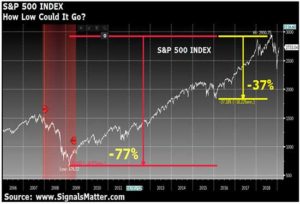At this very moment, U.S. and Chinese trade representatives are meeting in the hopes of establishing a "memorandum of understanding" against the backdrop of a potentially escalating trade war in which the United States already has a 10% tariff on over $200 billion worth of Chinese imports.
The deadline is, in theory, tomorrow, March 1. Trump, citing "good progress," has said he's willing to move the deadline for the tariff hammerblow back, though it could very well fall tomorrow.
But as of now, nothing has changed: The world's two top trading powers are hoping to avert the "mutually assured destruction" of a continuing trade war while simultaneously seeking to save face in their politicos' respective postal codes.
The United States was on the pointy end of a $375 billion trade deficit back in 2017; we imported more than $506 billion worth of Chinese products, while they imported just $130 billion of ours. It was initially easy to understand Trump's frustrations with such an imbalance.
Then again, if the United States wants to hate China for not buying enough U.S. widgets, from iPhones to blue jeans, then we should also hate U.S. CIOs at places like Apple Inc. (NASDAQ: AAPL), General Electric Co. (NYSE: GE), Nike Inc. (NYSE: NKE), and AT&T Inc. (NYSE: T).
After all, these companies "offshored" the manufacturing of "American" products to China for cheaper labor. This ultimately worked to the detriment of U.S. workers and the benefit of U.S. executive salaries. Disaffected U.S. voters of all stripes and persuasions are beginning to catch on to this.
Meanwhile, China's dictator, Xi Jinping, is more than aware of the problems inherent in keeping 1.4 billion citizens from losing faith in a schizophrenic economy, where the Shanghai Composite Index crashed to five-year lows in September against the S&P 500's all-time highs.
In short, there's a lot at stake from D.C. to Beijing. Neither leader wants to lose credibility at home; both leaders are looking to score a political and economic "win" on the global stage.
For those of us not named "Trump" or "Xi," who actually have to live in weakening, debt-soaked domestic economies, the downside is abundant...
So I'm going to show you how to protect yourself. You'll avoid losses, of course, and make some profits when things turn bad.
But, much better, you'll know how and when to buy into real value...
[mmpazkzone name="in-story" network="9794" site="307044" id="137008" type="4"]
Crippling Debt Levels Underpin Everything
Both the Chinese and U.S. economies are leveraged to insane, probably even lethal, levels.
Between 2003 and 2018, for example, the central banks of the world, including the People's Bank of China and the U.S. Federal Reserve, have expanded their collective balance sheets from $4 trillion to $25 trillion. That's a six-fold expansion of money printed out of thin air to "support" otherwise broken credit markets in their respective economies.
Collapse is inevitable. Recession will occur simultaneously or in a domino fashion with China, it seems, already the first to fall. In either case, the ripple effect will be felt in both U.S. and Chinese markets, as their fates are tied, regardless of how balanced or un-balanced their trade numbers are.
YOU KNOW IT IN YOUR GUT: Look at how things are going. Financial turmoil is coming just around the corner, maybe just a few months away. Click here...
With a "reported" debt-to-GDP ratio of only 47%, China's government, with its shadowy web of "state-owned enterprises" acts as both lender and borrower to itself. Government banks lend to government corporations, government pension funds and other state entities, effectively concentrating, rather than dispersing, China's massive systemic regulatory and credit risks, positioning it, like Greece, for a greater likelihood of systemic collapse. Unlike Greece, China's massive economy makes up 40% of global GDP. When it sputters, the rest of the world will, too.
China, alas, is a paper tiger in debt up to its ears, surviving via top-down rather than bottom-up growth; a national Ponzi scheme.
In fact, the level of borrowing China saw in January of 2019 is nothing less than surreal. China recently put all its chips on the debt table, borrowing 5% of its GDP in one month, which would equate to 60% of its GDP in a year, a level of borrowing not seen since the heights (or was that "depths?") of World War Two.
In other words, China, now sliding into a producer price index--confirmed deflation, is feeling the added pinch of the escalating trade war with the United States, a war that has nothing to do with tanks, bombers, or bayonets.
The truth is, nothing China "reports" about its internal mechanizations is really all that, well... true... Unofficial reports coming from the Institute of International Finance (IFF) place China's actual debt to-GDP-ratio at closer to 300%!
Such figures are appalling. They're a symptom of catastrophic rot - profoundly unsustainable.
And speaking of rotting and unsustainable, let's look at the other side of the trade battlefront: the United States.
FEAR... PANIC... MISTAKES... RUIN: Investors likely don't have much time left before chaos strikes, and there's zero margin for error. Click here for details...
Lest we get too carried away mocking centralized, state-owned, bipolar China, we can't call the U.S. economy - driven by a central bank - anything less than equally centralized. Yes, instead of a free market, we've morphed into a central-bank-supported market. Period. Full stop.
The U.S. sports a debt-to-GDP ratio of 105%. Like China, it is rotting from within, perched precariously atop a combined corporate, household, and government debt pile of $71 trillion - this against a no-growth GDP figure that has annualized at historical basement levels of just 1.7% since 2008.
When the global credit market in general, and the local bond markets in China and the United States in particular, fall under their own historically unprecedented debt weight, yields and rates will rise.
That will be a death blow; both countries, driven by debt rollover schemes, will hit a recession when the cost of that debt can't be sustained or "printed away."
Any general - any buck private, even - worth their salt will want to fight a war from high ground - from a position of strength...
The United States and China are fighting this trade war from a position deep in the quicksand.
Who could win such an ill-advised, poorly-sited pitched battle?
The short and blunt answer is this: Nobody wins, everybody loses.
Or, as French aviator and author Antoine de Saint-Exupéry wrote from the cockpit of his P-38 in 1941: "In war, there is no winner, there is only the last to rot."
Here's the Inevitable Outcome of an Unwinnable War
In such a rotten backdrop, high-risk stand-offs like a hot trade war with China and a potential 25% tariff on auto imports will just cause retaliatory reactions from China. They already have.
After all, in a war, both sides have weapons...
The net result will be higher costs for U.S. buyers of even more U.S. products, as the majority of them are, well... made in China.
In addition, U.S. exporters, burdened by a rising U.S. dollar, will find fewer Chinese buyers for their soybeans, say, and their cars, their oil, even their toasters.
Stated simply, no matter how much we want to stick it to them, a trade war against China is, in all practical terms, just a war against ourselves.
You Must Act Now: America is headed for an economic disaster bigger than anything since the Great Depression. If you lost out when the markets crashed in 2008, then you are going to want to see this special presentation...
Again, everybody rots...
U.S. exports to China, for example, fell by 34% through November of last year. In 2017, Chinese buyers accounted for 20% of all U.S. auto exports. Within 12 months, however, that percentage dropped to 12%.
As for U.S. farmers, 57% of their soybean exports went to China in 2017. As of today, soybean exports to China are down more than 70%. Ouch.
Even the U.S. oil industry has reasons to fear the impact of an escalating trade war. China ranks second only to Canada as a buyer of U.S. oil. In June of 2018, U.S. exports of oil to China totaled a record $1 billion. By August of 2018, however, China struck back and that number went from $1 billion to zero for September and October, as well.
Ouch. War is hell...
As I said, Trump has moved, but has not canceled, a deadline to increase the caliber of the economic bullets in this trade war, threatening to increase the current 10% tariff on key Chinese imports to 25%.
If some "memorandum of understanding" can postpone an escalation of this mutually rotting trade war, so be it.
Unfortunately, however, the die has already been cast.
China and the United States are already heading toward a disaster. They are both debt Titanics, heading toward a rising-rate iceberg. A heightened trade war will only increase the speed and destructive power of the collision. A "memorandum of understanding," if reached, will merely delay the inevitable.
You don't have to lose your shirt, though; that's not inevitable.
Here Are the Right Moves for Profit and Protection
The real issue today then is not "how to invest" in the backdrop of a trade war that neither country really wants nor can actually afford.
The real question today is how to invest in a world soaked in debt and a U.S. market driven by artificially suppressed interest rates.
One extremely popular, stupid, and altogether bad option is to continue to "seek yield" in misnamed "high-yield" junk bonds, which in fact offer very low yield for their very high risk.
Don't do that.
One possible move is to short stocks like Apple or Nike if the trade war indeed heightens today, tomorrow, or at any time in the near future. It's smart to reconsider any investments you might have in the U.S. automotive sector, or short names like Ford Motor Co. (NYSE: F). They're likely to get pinched.
The smartest option, of course, is the hardest of all. Why? Because it requires patience and common sense, two virtues that tend to wane when investors desperate to chase market tops lose all respect for the lessons of history and the power of mean reversion.
 You see, all markets, from time immemorial, eventually revert to their mean. This means that like a rubber band stretched from one's finger, they eventually coil back to their knuckle - that is, fall in price...
You see, all markets, from time immemorial, eventually revert to their mean. This means that like a rubber band stretched from one's finger, they eventually coil back to their knuckle - that is, fall in price...
Based on this unassailable market inevitability, mathematical mean reversion in the S&P 500 will result in drawdowns of anywhere from 37% to 77%, which is precisely when the smart money (now mostly in cash) gets back and buys at value rather than desperation.
So, you have to decide: Do you want to buy into desperation and rot today... or buy into value tomorrow?
You Could Be Paid $2,353
Very soon, we'll be releasing a very simple set of instructions to a selection of our readers.
Each person who follows these steps could be paid a total of $2,353 in only 28 seconds.
You won't need to buy a single share of stock up front to collect this cash. You won't need to spend a nickel on anything.
Follow Money Morning on Facebook, Twitter, and LinkedIn.
About the Author
25-year run as a hedge fund portfolio manager, family office chief investment officer, managing director and general counsel. Internationally recognized expert in credit and equity markets as well as macro risk management.



